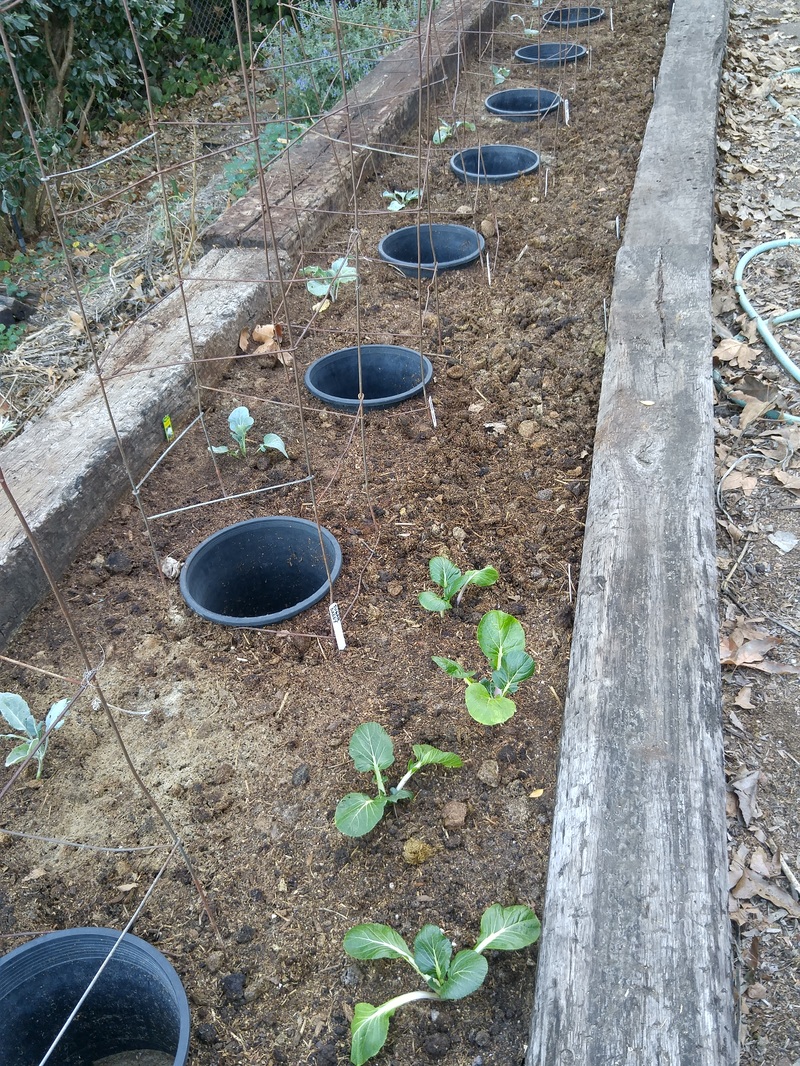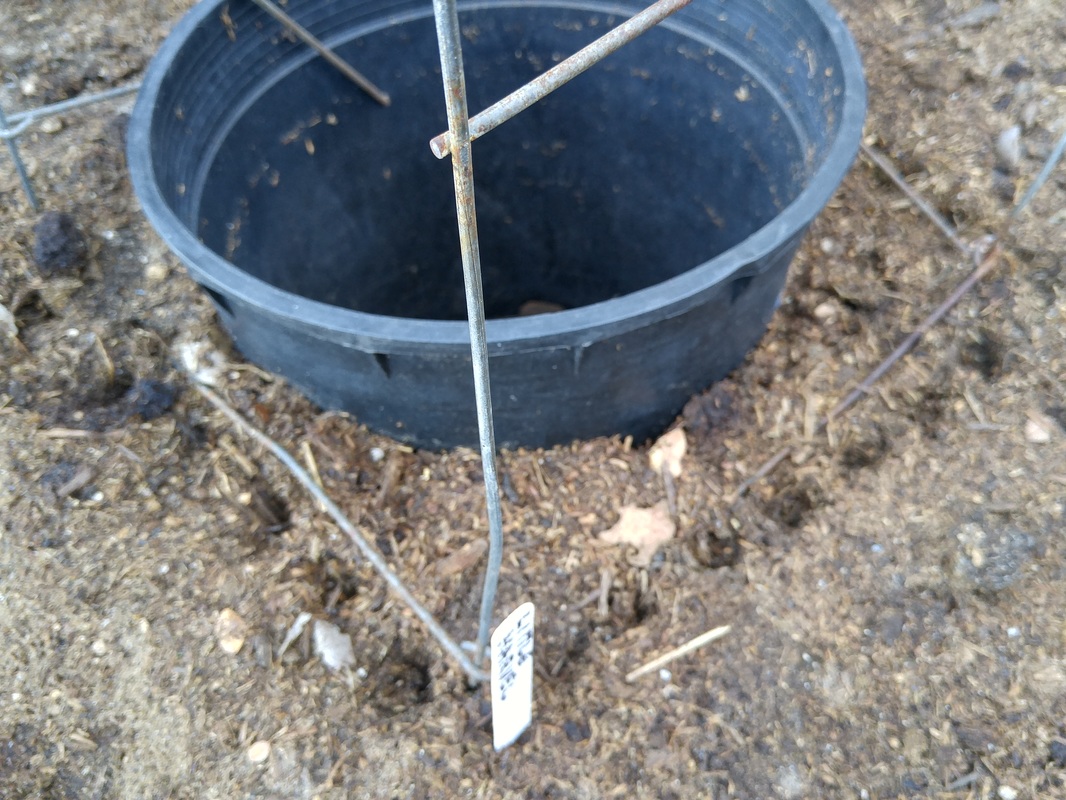| | I knew I might be too optimistic in purchasing the first veggie six-packs I could find of lettuce 2 months ago. Early fall and early spring are always a timing tossup since we never know whether the weather will stay cool or get hot again in the fall, or stay too cool or warm up in the spring. It’s always a guess of when to start what, especially when I want the new season’s edibles and perennials to get going as soon as possible. Both seeding and transplanting at the same time will mean that one option will win and the other option may lose. So I do both, to guarantee that at least one will work. It did get hot again – and again and again and again as it’s flip-flopped since then and we’re currently in a mid- to high-80s! swing. The lettuce from those six-packs that I’d transplanted did start to bolt and go to seed instead of producing edible leaves. So that expense and effort was a waste. But the seeds that I had also started came up just fine and so I transplanted them this past weekend. Yay! Here’re some pictures and techniques so you can get your seeds and transplants succeeding too! Sowing Wildflower Seeds With that bit of rain that we were promised – which ended up being a mere sprinkle but at least wet the pavement and top level of mulch – wildflower seeds that I’d scattered just before did sprout with some additional overhead irrigation to get the moisture a bit further down into the soil and mulch. Mulch that was left from last year’s plants provided nooks and crannies for the tossed seeds to lodge and touch soil and organic matter that became moist with the rain. That’s why you shouldn’t clear your soil, but instead crush dried foliage and small branches in place. Starting Seeds in Trays I love using my 30-year-old Speedling (R) trays for three reasons – 1. The Styrofoam insulates the potting soil and seeds to moderate temperature so seeds germinate more readily. 2. The tapered cell guides roots downward so there’s minimal transplant shock since the roots are already headed downward instead of circling around in six-packs. 3. Although the trays are relatively expensive to purchase, especially when also purchasing the drip trays (see www.groworganic.com), mine are now 30 years old so definitely worth the initial expense! Another suggestion if you choose to purchase them – the trays come in several cell sizes, so choose according to your needs or tendencies to delay transplanting. Initially, I purchased the one-inch cells since I thought I’d get the most number of plants for the purchase price. But, it turned out that I’d always waited too long before transplanting them, so many died because the tiny cells didn’t allow them enough space to develop further until I was ready. Instead, I purchased the three-inch cell size because I wanted an extensive root system before I transplanted them. And I continue to use the one-inch cell tray for my leeks, making sure to sow only two seeds in each cell, which makes it perfect for easy transplanting without further effort. Speaking of careful sowing – this time, I let a bunch of seeds fall into each cell, figuring that I’d gently pull them apart when transplanting. But this ended up being a problem because they were so tiny and delicate, and I had to separate them and transplant each into six-pack cells just to give them more vitality with new potting mix. So it ended up adding an extra step before having them develop large enough to transplant into the garden where they’d mature. So, don’t do what I did this time. Instead, make the extra effort to release only 2 seeds into each cell so each germinated sprout will have sufficient soil mix to develop fully into transplant size. Then you can either pull the two plantlets apart or snip one off at its base, not disturbing the root system of the remaining transplant. Starting Seeds Directly in the Soil Rough up the soil with a handfork so it’s loose a good three inches down and there are no clumps larger than half an inch. Scatter small seeds of carrots, beets, cilantro, parsley and others that you’ll harvest en mass so they fall from half to one inch apart. Place larger seeds like peas about one inch apart, and push no more than one-half to one inch into the soil – shallower if heavy soil, deeper if soil has lots of compost. Sprinkle water gently to settle the seeds into good contact with the soil particles with barely any soil on top. Scatter a very, very thin layer of compost or potting mix on top to help anchor the seeds in place so they don’t swim away with each watering. Sprinkle again in morning and evening every other day to keep soil moist but not soaking. It may take up to 3 weeks for carrots and parsley to emerge – just when you’ve forgotten about them, they pop up – so keep that soil moist! Transplanting into the Soil Be sure to water the seedlings before removing them so their rootballs come out easily. From Speedling trays, insert a paring knife down the side of the cell and pop the seedling out. From a six-pack, push gently from the bottom and then hold sideways or upside down so gravity will let the rootball fall into your hand. In both cases, handle the seedling only by the leaves, not the stem. If you crush any leaves, the plant can grow more. But if you crush the stem, it can’t grow another one so will die. Place transplants according to the size the plants will be when mature. For example, place bok choy about eight inches apart (about the width of your outstretched hand from tip of your thumb to the tip of your small finger), but cabbage and cauliflower about 3 feet apart. Place plants according to when you’ll harvest them. Cabbage and cauliflower I place at the back of a bed where I can’t easily reach because they’ll grow until they’ll mature in a couple of months. Lettuce and bok choy and spinach I place at the front of a bed where I can easily reach for frequent harvesting, at least once a week during the winter. Triangulate plants like lettuce and bok choy for best use of root and surface space. You want foliage of each plant to barely reach the next plant, to shade the soil. This will also provide enough space for extensive root systems. During winter, for plants like lettuce and bok choy, which you’ll harvest the outer leaves frequently, you can plant more closely together than plants you’ll wait until they’re mature before harvesting. |
|
10 Comments
7/7/2022 07:27:09 am
I agree with this! This is surely a great help to the newbies out there who lacks some knowledge about planting,
Reply
7/7/2022 07:51:34 am
Interesting post! People who's just starting out planting will have all the advantages and avoid doing redundant mistakes.
Reply
Leave a Reply. |
Categories |









 RSS Feed
RSS Feed